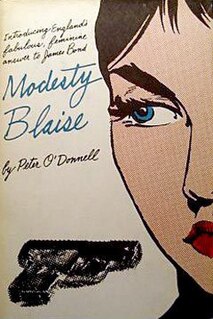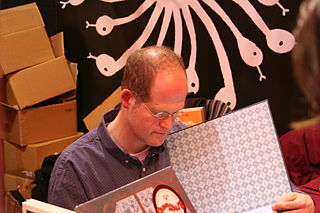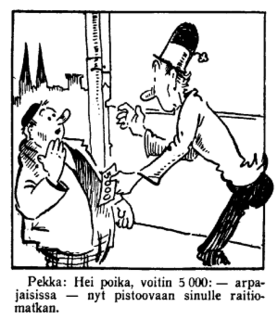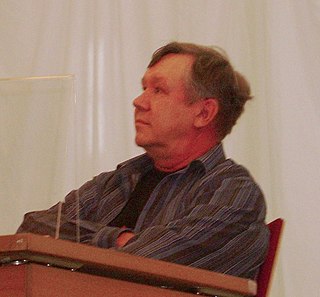
A comic book or comicbook, also called comic magazine or simply comic, is a publication that consists of comic art in the form of sequential juxtaposed panels that represent individual scenes. Panels are often accompanied by brief descriptive prose and written narrative, usually dialog contained in word balloons emblematic of the comics art form. Although comics has some origins in 18th century Japan, comic books were first popularized in the United States and the United Kingdom during the 1930s. The first modern comic book, Famous Funnies, was released in the U.S. in 1933 and was a reprinting of earlier newspaper humor comic strips, which had established many of the story-telling devices used in comics. The term comic book derives from American comic books once being a compilation of comic strips of a humorous tone; however, this practice was replaced by featuring stories of all genres, usually not humorous in tone.

The Yellow Kid was the name of a lead American comic strip character that ran from 1895 to 1898 in Joseph Pulitzer's New York World, and later William Randolph Hearst's New York Journal. Created and drawn by Richard F. Outcault in the comic strip Hogan's Alley, it was one of the first Sunday supplement comic strips in an American newspaper, although its graphical layout had already been thoroughly established in political and other, purely-for-entertainment cartoons. Outcault's use of word balloons in the Yellow Kid influenced the basic appearance and use of balloons in subsequent newspaper comic strips and comic books.

Comics is a medium used to express ideas by images, often combined with text or other visual information. Comics frequently takes the form of juxtaposed sequences of panels of images. Often textual devices such as speech balloons, captions, and onomatopoeia indicate dialogue, narration, sound effects, or other information. Size and arrangement of panels contribute to narrative pacing. Cartooning and similar forms of illustration are the most common image-making means in comics; fumetti is a form which uses photographic images. Common forms of comics include comic strips, editorial and gag cartoons, and comic books. Since the late 20th century, bound volumes such as graphic novels, comic albums, and tankōbon have become increasingly common, while online webcomics have proliferated in the 21st century.
Disney comics are comic books and comic strips featuring characters created by The Walt Disney Company, including Mickey Mouse, Donald Duck and Uncle Scrooge.

Modesty Blaise is a British comic strip featuring a fictional character of the same name, created by author Peter O'Donnell and illustrator Jim Holdaway in 1963. The strip follows Modesty Blaise, an exceptional young woman with many talents and a criminal past, and her trusty sidekick Willie Garvin. It was adapted into films in 1966, 1982, and 2003, and from 1965 onwards eleven novels and two short story collections were written.

Franklin Christenson "Chris" Ware, is an American cartoonist known for his Acme Novelty Library series and the graphic novels Jimmy Corrigan, the Smartest Kid on Earth (2000) and Building Stories (2012). His works explore themes of social isolation, emotional torment and depression. He tends to use a vivid color palette and realistic, meticulous detail. His lettering and images are often elaborate and sometimes evoke the ragtime era or another early 20th-century American design style.

The Dandy was a British children's comic published by the Dundee based publisher DC Thomson. The first issue was printed in December 1937, making it the world's third-longest running comic, after Il Giornalino and Detective Comics. From August 2007 until October 2010, it was rebranded as Dandy Xtreme.

Speech balloons are a graphic convention used most commonly in comic books, comics and cartoons to allow words to be understood as representing the speech or thoughts of a given character in the comic. There is often a formal distinction between the balloon that indicates thoughts and the one that indicates words spoken aloud: the balloon that conveys thoughts is often referred to as a thought bubble.
A daily strip is a newspaper comic strip format, appearing on weekdays, Monday through Saturday, as contrasted with a Sunday strip, which typically only appears on Sundays.

A topper in comic strip parlance is a small secondary strip seen along with a larger Sunday strip. In the 1920s and 1930s, leading cartoonists were given full pages in the Sunday comics sections, allowing them to add smaller strips and single-panel cartoons to their page.
Willie Lumpkin is a fictional supporting character appearing in American comic books published by Marvel Comics. The character is best known as the mailman of the Fantastic Four in their self-titled comic book.
Peräsmies is a Finnish underground comic strip drawn by Timo Kokkila that appeared in the Pahkasika magazine from 1983 to 2000.

Pekka Puupää is a Finnish text comic and film character, created by Ola "Fogeli" Fogelberg. The character appeared 1925–1975 in the popular comic Pekka Puupää and 1952–1960 in thirteen films produced by Suomen Filmiteollisuus. Pekka Puupää is one of the most well-known and beloved characters in the Finnish popular culture.

Krazy Kat is an American newspaper comic strip by cartoonist George Herriman (1880–1944), which ran from 1913 to 1944. It first appeared in the New York Evening Journal, whose owner, William Randolph Hearst, was a major booster for the strip throughout its run. The characters had been introduced previously in a side strip with Herriman's earlier creation, The Dingbat Family. The phrase "Krazy Kat" originated there, said by the mouse by way of describing the cat. Set in a dreamlike portrayal of Herriman's vacation home of Coconino County, Arizona, KrazyKat's mixture of offbeat surrealism, innocent playfulness and poetic, idiosyncratic language has made it a favorite of comics aficionados and art critics for more than 80 years.

Tarmo Koivisto is a Finnish comics artist and writer, cartoonist, and graphic artist. He is best known for his ongoing comic strip Mämmilä. Koivisto is also known by his artist name Tape.

Donald Duck is a cartoon character created in 1934 at Walt Disney Productions. Donald is an anthropomorphic white duck with a yellow-orange bill, legs, and feet. He typically wears a sailor shirt and cap with a bow tie. Donald is most famous for his semi-intelligible speech and his mischievous and temperamental personality. Along with his friend Mickey Mouse, Donald is one of the most popular Disney characters and was included in TV Guide's list of the 50 greatest cartoon characters of all time in 2002. He has appeared in more films than any other Disney character, and is the most published comic book character in the world outside of the superhero genre.

Fingerpori is a Finnish comic strip written and drawn by Pertti Jarla. It started in Helsingin Sanomat in February 2007, and is currently syndicated in Satakunnan Kansa, Aamulehti, Karjalainen, Keskisuomalainen, Turun Sanomat and Etelä-Saimaa. Several strip collections in album format have also been published.
Notable events of 1930 in comics. See also List of years in comics.
















